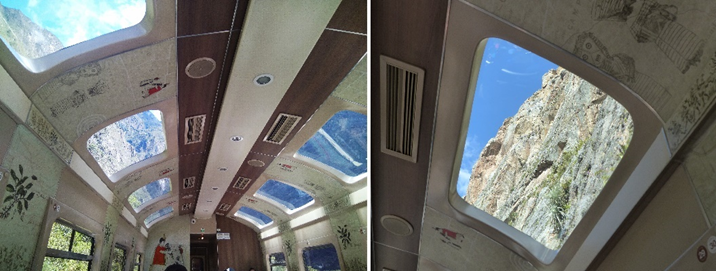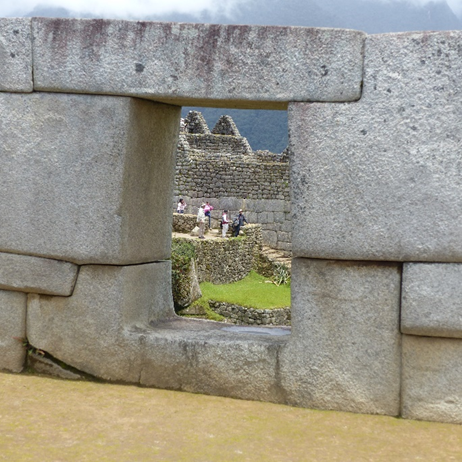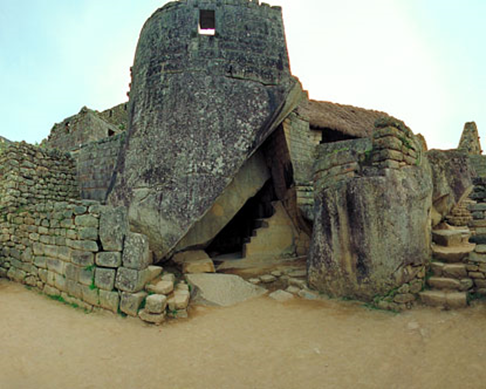The Inca
Citadel of Machu Picchu in Peru
One of the Seven
Wonders of the World
Travelogue 35
The
ancient ruins of Machu Picchu serve as a reminder that even the greatest
civilizations will eventually fade away. Let us cherish the present while it lasts.
Turn Right at Machu Picchu
Mark Adams
[Panoramic view of Machu Picchu – Courtesy Wikipedia]
The remote ancient Incan citadel of Machu Picchu in Peru, South America,
is one of the Seven New Wonders of the World, and the country’s most famous
tourist attraction. In this travelogue,
I relive my memorable experience of having visited it in Jan 2019 as part of my
tour of the continent.
Prelude
In a previous blog article (see here), I had narrated how
I had completed a sweep of all seven manmade modern Wonders of the World,
beginning with the Taj Mahal as far back as 1963, and ending with Chichen
Itza in April this year, giving brief descriptions of each. I had also indicated that they would each be
supported by more detailed articles in subsequent blogs. As it so happens, I
have already posted such descriptive articles in respect of the Taj Mahal and the
Great Wall of China earlier (see here, and here). I now address myself to Machu Picchu
in Peru in this travelogue.
Location
Situated at an altitude of about 2,500 meters
in a place of great natural beauty, in the middle of a tropical mountain
forest, the sanctuary of Machu
Picchu is
apparently the most amazing architectural achievement of the Inca Empire at its
peak. It is about 80 km northwest of the
ancient city of Cusco (see map below), and sits on a ridge between the Huayna Picchu and Machu
Picchu mountains, overlooking the Urubamba River valley.
Geography
Machu Picchu’s location is both spectacular and
strategic. Nestled high in the Andes, it is surrounded by lush, green peaks,
with steep cliffs dropping into the river below. The region is part of the
Amazon rainforest, which gives the site a tropical yet temperate climate. The
elevation creates a microclimate where mornings are often misty, with clouds
rising from the valley and breaking to reveal the grandeur of the site.
History
Machu Picchu was built in the 15th century, around
1450, during the reign of the Inca emperor Pachacuti. It is believed to have
served as a royal estate or a religious site for Inca nobility. The site
remained hidden from the outside world until American historian and explorer
Hiram Bingham rediscovered it in 1911. Since then, Machu Picchu has become a
symbol of Incan civilization and an important reminder of pre-Columbian
history. The citadel was never discovered by the Spanish conquistadors, which
is why it is so well-preserved today.
Importance
Machu Picchu is not only one of the most famous
archaeological sites in the world, but also a UNESCO World Heritage site,
designated in 1983. It is considered one of the New Seven Wonders of the World
due to its architectural significance and beauty. The site is an excellent
example of the Inca’s sophisticated engineering, agriculture, and spiritual
connection to nature. Terraces, irrigation systems, and stone structures
demonstrate their ability to adapt to difficult terrains. Machu Picchu
continues to attract scholars and researchers interested in Incan history,
culture, and astronomy.
Its walls, terraces and gigantic ramps give
the impression of having been sculpted into the rock escarpments, as if they
were part of it. The natural setting, located on the eastern slope of the
Andes, is part of the upper Amazon basin, which has a very varied flora and
fauna. Most of the outlying buildings have been reconstructed in order to
give visitors a better idea of how they originally appeared. By 1976, 30
percent of Machu Picchu had been restored and the restoration
work still continues. The Incas built the establishment around 1450 AD but
abandoned it a century later, at the time of the Spanish conquest.
Tourist Information
Visiting Machu Picchu is a must-do item for travelers
worldwide. The site is open year-round, though the best time to visit is during
the dry season from May to September. The rainy season from November to March
can make the trails slippery, but the crowds are thinner during this time. A
typical visit allows tourists to explore the main parts of the citadel,
including the Temple of the Sun, the Intihuatana stone (a ritual stone
associated with astronomical observations), and the Room of the Three Windows.
There are also more strenuous hikes, such as climbing Huayna Picchu or the
Machu Picchu Mountain for panoramic views.
How to Reach Machu Picchu from Cusco
There are several ways to reach Machu Picchu from
Cusco, which itself can be reached easily by air service from the Peruvian
capital Lima.
- Train: This is the most popular and comfortable
option. The slow train journey takes about 3 to 4 hours from the town of Poroy
(about 20 minutes from Cusco) or Ollantaytambo (a little further
from Cusco). Trains, such as the Vistadome and the more luxurious Hiram
Bingham service, offer stunning views of the Andean landscape, following
the Urubamba River to Aguas Calientes, the town nearest to Machu Picchu.
- Hiking (Inca Trail): For adventure seekers, hiking the Inca
Trail is an unforgettable experience. This typically 4-day trek takes
travelers through beautiful mountain passes, cloud forests, and Inca
ruins, culminating with a sunrise arrival at Machu Picchu’s Sun Gate.
There are also shorter versions of the Inca Trail (2 days), but all
require advance booking as permits are limited. A part of the Inca trail
is captured in the picture below:
- Bus from Aguas Calientes: Once in the town of Aguas
Calientes, visitors must take a 25-minute bus ride up a steep mountain
road (see picture below) to reach the
entrance of Machu Picchu. Alternatively, a strenuous hike from Aguas
Calientes to the site is possible, but it takes about 1 to 2 hours.
- Advance Booking: Tickets to Machu Picchu, especially for the
Inca Trail and climbs up Huayna Picchu, sell out quickly. It’s recommended
to book months in advance, especially during peak season (June to August).
- Altitude Acclimatization: Cusco and Machu Picchu are at
high altitudes, which can cause altitude sickness. It's worthwhile to
spend a day or two acclimatizing in Cusco before heading to Machu Picchu.
Staying hydrated and avoiding heavy meals may help.
- What to Bring: Carry light clothing, sunscreen, insect
repellent, and plenty of water. Layers are important as mornings can be
cold and misty, but the weather warms up quickly.
- Respect the Site: Machu Picchu is a protected site, and
strict rules are in place to preserve its integrity, though not as
strictly enforced. Stay on marked paths, and avoid climbing or touching
the ancient structures.
- Best Time to Visit: Early morning visits offer quieter, more
intimate experiences and are less likely to coincide with crowds.
Alternatively, late afternoon also offers fewer tourists and softer
lighting for photography.
The Journey
I was part of a tourist group of about thirty
originating from Bangalore on a sightseeing trip to several south American
countries including Peru. We had flown to Cusco from the Peruvian capital of
Lima, with a whole day set apart for the visit to Machu Picchu. Though only
about 80 km from the ancient Peruvian city of Cusco, it was a long winding journey
to Machu Picchu in the Peruvian Andes, first by train up to Aguas Calientes
from where another segment of the journey is performed by smaller trams, and
then by road right up to the base camp.
Here are two spectacular views through the
glass covered roof and sides of the tourist train which we boarded at Ollantaytambo station (see below).
Below is a picture of me basking in the bright
sun and lush greenery after alighting at Aguas Calientes for a short wait
before journeying on to Machu Picchu.
Arrival
The picture below shows the main entrance to Machu Picchu and the arrival spot for buses from Aguas Calientes. Those without advance booking can also purchase tickets here if available on demand.
From here on, it is a short but steep climb
(see picture below) to reach the heights of Machu Picchu for a wonderful
panoramic view as captured in the lead picture to this article.
Below are two photographs of me in obvious
triumph and delight at reaching this picturesque spot after a strenuous climb up
a narrow and steep rock-hewn pathway. Paradoxically, the second one was taken
in bright sunshine and at a slightly different angle shortly after a light
cloudburst; hence the umbrella still in my hand.
Here is another view in bright light, at yet another
angle:
Exploring Machu Picchu
Below is a map of Machu Picchu showing some of the main attractions
for a visitor, with their locations with respect to each other easy to make out:
What followed was over two hours of walking
through the various parts of the site, exploring the intricate web of buildings
and surrounding terrain. Below is a view of parts of the labyrinthine structures within the Machu
Picchu complex:
An eye-catching feature of Machu Picchu is the steep
terraces used for farming activities. Here is a view I captured from a distance:
Incan Astronomy
Machu Picchu offers evidence that the Incans had made significant
progress in observational astronomy. Its design reflects a sophisticated
knowledge of celestial events.
Sun Worship and Alignment: The Incas were Sun
worshippers, and many structures at Machu Picchu are aligned with astronomical
phenomena, particularly the movements of the Sun. For example, the Intihuatana
Stone (see picture below), often called the ‘Hitching
Post of the Sun’, is believed to have served as a solar clock or calendar.
During the solstices, the stone’s alignment tracks the Sun's position, and it
is thought that the Incas used it to mark important agricultural dates.
Temple of the Sun: Another significant structure is the Temple of the
Sun (including the semicircular structure in the picture below), where the windows
are aligned to capture the sunlight during the solstices. On the June solstice,
sunlight passes through one of the temple's windows and illuminates a specific
stone inside, signifying the change in season. This demonstrates the Incas’
ability to incorporate astronomy into their architecture.
The sculpture (see picture below) projecting from the rock bottom of the Sun
temple is interpreted as "Water mirrors for observing the sky".
The Incas used Machu Picchu’s high-altitude location
to observe the stars and other celestial bodies. They carefully studied the
movements of the planets, stars, and the Milky Way, which they considered
sacred. The constellation of the Southern Cross, for example, played a key role
in their perception of cosmology.
Machu Picchu’s design is a testament to the Inca's considerable
astronomical knowledge, blending their religious beliefs with the
practicalities of agriculture and timekeeping through the observation of
celestial events.
Temple of the three windows: This is one of the most iconic structures at
Machu Picchu. It gets its name from the three large windows that overlook the
eastern section of the site (see picture below). These windows provide a stunning view
of the surrounding mountains and valleys.
The temple is believed to have had religious or
ceremonial importance, possibly related to the Incan Sun God, Inti. The
windows may have symbolized important aspects of Incan cosmology, such as the
three realms of existence: the sky, the earth, and the underworld.
The construction of the temple, like much of Machu
Picchu, demonstrates the incredible precision of Incan masonry, with massive
stones carefully cut and fitted together without mortar. The structure
highlights the architectural and astronomical knowledge of the Incas.
Temple of the Condor: The Temple of the Condor in Machu
Picchu (see my picture below) is a breathtaking example of Inca stonemasonry. A
natural rock formation began to take shape millions of years ago and the Inca skilfully
shaped the rock into the outspread wings of a condor in flight. On the floor of the
temple (see the foreground in the picture) is a rock carved in the shape of the
condor's head and neck feathers, completing the figure of a three-dimensional
bird.
Royal Tomb: This cave-like area (see picture below) of Machu
Picchu contains ceremonial niches and an Inca cross carved from one wall and is
adjacent to the Temple of the Sun.
Return Journey
The return journey was disrupted by a huge
down pour lasting well over an hour and we were stranded close to the railway
station (see picture below). It was lucky that this did not happen on the
outward journey. But for this, our return journey to Cusco was uneventful.
Conclusion
Machu Picchu is a place that blends nature, history,
spiritual connection and civilizational impact, making it one of the most
awe-inspiring destinations in the world. Whether through a scenic train journey
or a challenging trek, visiting Machu Picchu is a transformative experience for
any traveler. The visit to Machu Picchu left a lasting impression on me, next
only to the Taj Mahal and the Great Wall of China, as a truly great wonder of
the world, fully deserving the accolade.
Tailpiece
There were two sisters in our tour group with strong physical
similarities and the rest of us started referring to them fondly as Machu
and Picchu without their knowledge, their real names almost forgotten.
The day before our visit to Machu Picchu, Machu had taken ill and
preferred to rest in the hotel, Picchu also staying back to provide comfort
and care. By the time we reached the
entrance gate to Machu Picchu, Machu was in no condition to climb up to
the site of the ruins, and Picchu too opted to stay back to tend to her
sister. So did a few others in the group who were either too tired or not
sufficiently motivated to continue on. I had no reason not to, for Machu Picchu
was the very raison
d'être for my trip
to South America. It is a great pity
they had to miss out on what was anticipated to be the pièce de résistance
of our entire South American trip.






















